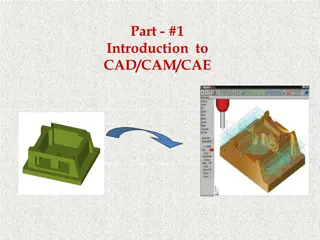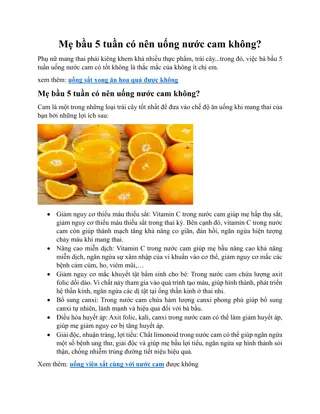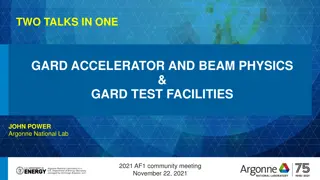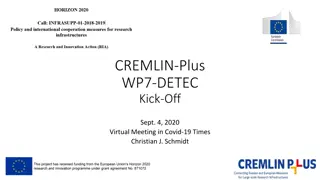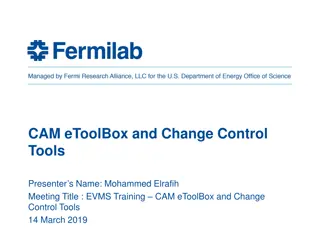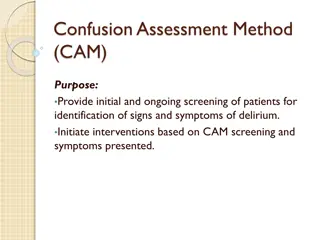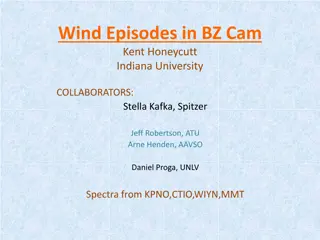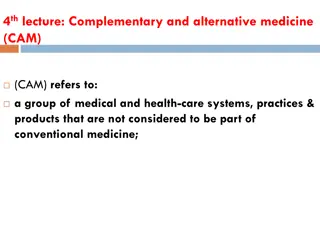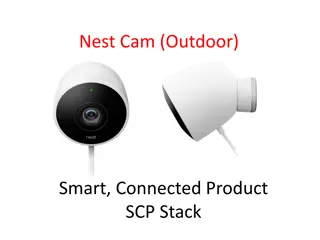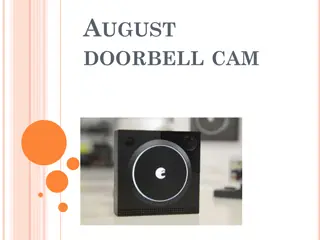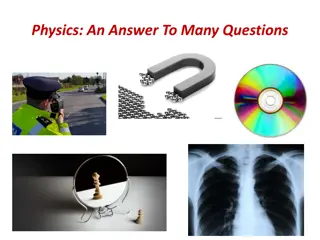Advancing CAM Physics Framework: Challenges and Innovations
Community Physics Framework (CPF) addresses challenges in CAM6 architecture, promoting interoperability for new physics suites while enhancing model flexibility. The CPF aims to replace hardcoded logic with a more adaptable, data-driven approach for seamless integration of physics parameterizations in atmospheric modeling.
Download Presentation

Please find below an Image/Link to download the presentation.
The content on the website is provided AS IS for your information and personal use only. It may not be sold, licensed, or shared on other websites without obtaining consent from the author.If you encounter any issues during the download, it is possible that the publisher has removed the file from their server.
You are allowed to download the files provided on this website for personal or commercial use, subject to the condition that they are used lawfully. All files are the property of their respective owners.
The content on the website is provided AS IS for your information and personal use only. It may not be sold, licensed, or shared on other websites without obtaining consent from the author.
E N D
Presentation Transcript
CPD Joint GEOS-Chem and NCAR Modeling Workshop: 2018-07-30 A Community Physics Framework for CAM Cheryl Craig, Steve Goldhaber, Mariana Vertenstein Francis Vitt (CGD) Michael Duda, Dave Gill (MMM) Steve Goldhaber 9/25/2024 1 Tel: 303.497.1770 | Email: goldy@ucar.edu
Outline Outline Brief overview of CAM6 infrastructure changes Some challenges ahead for CAM and atmospheric modeling Introduction to the Community Physics Framework Community physics at NCAR and beyond Why is chemistry challenging? Steve Goldhaber 9/25/2024 2 Tel: 303.497.1770 | Email: goldy@ucar.edu
CAM6 CAM6 Architecture Overview CESM Driver / Mediator Hardcoded logic leads to duplicated code Run Parameters Surface Coupling CAM Driver Dynamics Physics CAM Physics CAM Dynamics State CAM4 CAM5 CAM6 Simple Models Chemistry Suites Coupling Tendencies FV SE Eulerian Code is not interoperable high cost to import new physics parameterizations. Initial Data (input) and Diagnostics (output) Steve Goldhaber 9/25/2024 3 Tel: 303.497.1770 | Email: goldy@ucar.edu
CPF Requirements for CAM Physics -- after CAM6 Support for new physics suites (packages) while maintaining ability to run older suites Interoperable development of new unified physics suites Ability to continue to run mainline CAM physics suites Interoperability between NCAR atmosphere models (WRF, MPAS, CAM) For example, run WRF physics inside CAM without any changes to parameterizations or suite definition Ability to run chemistry and/or physics on different grid from dynamics Ability to run interoperable physics or chemistry suites from other institutions. Steve Goldhaber 9/25/2024 4 Tel: 303.497.1770 | Email: goldy@ucar.edu
CPF What is wrong with what we have? CAM physics parameterizations depend on several CAM-specific data structures (physics_state, physics_tend, surface fields in, surface fields out, PBUF). Other models have very different state data structures. This inhibits portability between models. physpkg (tphysbc, tphysac) logic has combined implementation of CAM3, CAM4, CAM5 & CAM6 including several options for CAM5 and CAM6 Increases difficulty in experimenting with new physics parameterizations and suites. Steve Goldhaber 9/25/2024 5 Tel: 303.497.1770 | Email: goldy@ucar.edu
CPF What is the Community Physics Driver / Framework? Multi-model effort to build flexible physics-package driver with a common, model-independent interface Replaces hardcoded, complex logic with a data-driven schedule of parameterization calls Handles data flow to and from host model as well as between parameterization calls Recently funded for implementation by CGD (CAM), MMM (WRF & MPAS), ACOM (Chemistry package) Goal is to also be compatible with NOAA (NGGPS, CCPP) Steve Goldhaber 9/25/2024 6 Tel: 303.497.1770 | Email: goldy@ucar.edu
CAM6+ CAM6 with Community Physics Driver CESM Driver / Mediator Run Parameters Surface Coupling CAM Driver Tendencies Community Physics Driver CAM Dynamics SE MPAS FV Eulerian State Fields Dynamics Physics Coupling CPD Physics Suites (CAM6, WRF, etc.) Initial Data (input) and Diagnostics (output) Steve Goldhaber 9/25/2024 7 Tel: 303.497.1770 | Email: goldy@ucar.edu
CAM6 CPF CAM6 Physics vs. CPF Surface Fields Dynamics State CPF Test Driver Host Model CAP Diagnostics CPF Parameterization Parameterization Parameterization Parameterization Parameterization Parameterization Diagnostics Parameterization Parameterization Parameterization Parameterization Parameterization Parameterization PBUF Steve Goldhaber 9/25/2024 8 Tel: 303.497.1770 | Email: goldy@ucar.edu
Parameterization CAM6 Physics vs. CPF Parameterization Gather data from state, previous tendencies, & physics buffer Update state, tendencies, physics buffer & diagnostic output Parameterization Cap (Fortran code generated from Parameterization metadata) Parameterization portable layer (all I/O through Fortran arrays) Examples: microphysics, cloud physics, radiation Parameterization portable layer (all I/O through Fortran arrays) Examples: microphysics, cloud physics, radiation Steve Goldhaber 9/25/2024 9 Tel: 303.497.1770 | Email: goldy@ucar.edu
CPF Summary I Physics parameterizations and suites can be shared among models without modification. The Community Physics Framework creates a uniform data interface for parameterization inputs and outputs. Shared infrastructure lowers coding, testing, and maintenance costs. Well-documented interfaces makes it easier for the community to contribute usable parameterizations. Framework helps to manage model complexity. Steve Goldhaber 9/25/2024 10 Tel: 303.497.1770 | Email: goldy@ucar.edu
CPF What will change Parameterizations will not have a custom interface (which is different for each host model). This will be replaced with a metadata header (written as a Fortran comment block) which describes the interface needs of the parameterization. Physics suites will not be written as hand-coded Fortran logic. This will be replaced with a dataflow description of the suite s process ordering. What will not change The portable core of each parameterization will not have to change Steve Goldhaber 9/25/2024 11 Tel: 303.497.1770 | Email: goldy@ucar.edu
CPF Summary II CPF will improve data provenance by requiring standard metadata for every field The interface code and driver loop will be generated, lowering redundant code and opportunities for error CPF can provide development / testing framework Code generation can be flexible to accommodate the needs of different models. Framework helps to manage model complexity Steve Goldhaber 9/25/2024 12 Tel: 303.497.1770 | Email: goldy@ucar.edu
Chemistry Interactions between chemistry and other physics Pop quiz: who handles wet deposition? Each parameterization (e.g., chemistry) may create an array for its constituent properties. Example properties: Advected Wet removed Dry deposited Used for radiative heating rates Array is processed by host model to ensure all constituents are handled appropriately. In progress key to success of modularization Steve Goldhaber 9/25/2024 13 Tel: 303.497.1770 | Email: goldy@ucar.edu
NUOPC Subroutine or Component? Current CPF design will allow any compliant suite to be run in any compliant model (called as a subroutine) NUOPC CPF Future plans to build NUOPC cap to allow compliant suite to be used as a NUOPC component We hope that the highly structured interfaces of the CPF will allow a single, generic NUOPC cap to be useful for all suites Parameterization Parameterization Parameterization Parameterization Parameterization Parameterization Steve Goldhaber 9/25/2024 14 Tel: 303.497.1770 | Email: goldy@ucar.edu
CPF CPF development plan CPF funded 2018-01-30 Plan is to demonstrate a single physics suite focused on future, unified physics research ideas Software team: Cheryl Craig, Michael Duda, Dave Gill, Steve Goldhaber, Mariana Vertenstein, Francis Vitt Requirements definition complete, working on implementation CPF demonstration in demo chem model CPF demonstrated in CAM, MPAS, and WRF by end of year Steve Goldhaber 9/25/2024 15 Tel: 303.497.1770 | Email: goldy@ucar.edu
Questions Thank You Questions? Steve Goldhaber 9/25/2024 16 Tel: 303.497.1770 | Email: goldy@ucar.edu
CPF Brief CPF history to date Early 2016: GMTB begins work on Common Community Physics Package (CCPP). May 2017: Jim Hurrell asks small software team for proposal on unified infrastructure for atmospheric modeling at NCAR. Whitepaper delivered at end of July. November 2017: CPD section of unified infrastructure submitted as proposal for reinvestment funds. Q1 2018: CCPP v1 released demonstrating GFS physics running in FV3 and in GMTB single column model. Steve Goldhaber 9/25/2024 17 Tel: 303.497.1770 | Email: goldy@ucar.edu




